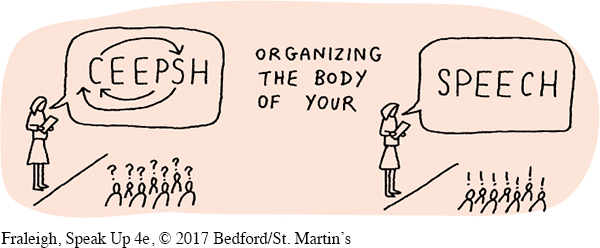Chapter 9 ORGANIZING YOUR SPEECH

Look for the  and
and  throughout the chapter for adaptive quizzing and online video activities.
throughout the chapter for adaptive quizzing and online video activities.
Page 253
“Good organization makes the message clear.”
Carly stood at the lectern and began her speech. After trying to build audience interest by telling a joke about a leading fashion magazine, Carly revealed that her speech would be about magazines targeted to women and girls. She then launched into her topic. Showing her listeners several magazine advertisements featuring gaunt models, Carly explained how listeners could help friends struggling with anorexia or bulimia. One of the ads was for cosmetics, and Carly presented evidence supporting the claim that the testing of cosmetics harms animals. Carly also showed several magazine articles with titles she considered inane—
Carly concluded her speech with a plea for audience members to cancel their subscriptions to women’s magazines. Then she sat down, feeling confident that she had scored a success with her audience. When they evaluated her speech, however, many classmates said they’d had trouble following her presentation. Some admitted that they’d found her ideas downright confusing. Surprised and upset by the feedback, Carly didn’t realize that she had made an all-
Page 254
Carly’s story reveals the importance of organization in developing a successful speech. When you organize your ideas clearly, you help audience members see how the different ideas in your presentation fit together, which allows them to better comprehend your message.1 They know what to listen for because your organization provides cues to indicate the main ideas. And they don’t have to devote their mental energy to figuring out what your main points are and how all the details in your speech relate to those points.
Good organization is particularly important in oral communication because listeners don’t have the luxury of reviewing printed information to understand your message. By contrast, those who are reading a printed message—
When you organize your speech clearly, you also enhance your credibility. Effective organization shows that you have taken the time to prepare your talk.2
Organizing a speech is not merely a matter of applying an arbitrary set of rules. Rather, a well-

Page 255
In this chapter, we focus on organizing the body of your speech—